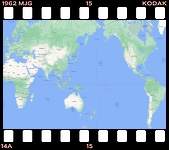Buster’s bus was waiting at 7 am to take us all to the foot of Uluru. We looked up at it – the summit is 348 metres (1142 feet) above the level of the surrounding desert. Buster claimed that the records for the fastest ascent and the fastest descent are both 15 minutes – this being to the marker at the very top.
Before this, it hadn’t been immediately obvious that non-rock-climbers can get up the famous monolith, since from all angles in the normal photos, the sides look pretty steep.
But near where we parked, there was a ramp leading to a ridge, providing a route which had some steel handrails and ropes on the steeper bits, for people to get up and down in safety. Being an experienced hill walker with some rock climbing ability, I threw myself at the task enthusiastically, found that the Vibram soles of my boots gripped very well on the coarse-grained sandstone. I had no need of the rope handrail on the way up, and went swiftly past the regular folk, who were panting, and grasping the rope with their white knuckled hands.
The view opened up nicely as I got near the summit, but there was a problem! Having been in the Uluru area for 18 hours I had got used to the huge photogenic monolith dominating the unique scenery. However, up here, Uluru was gone! The scenery was now just boring flat semi desert in all directions – apart form the Olgas in the distance. I reached the summit 23 minutes after starting, which didn’t seem too bad given that I wasn’t exactly racing.
After relaxing and taking several photos I decided that I would hurry down, and jogged off from the summit across the flattish top. I continued jogging down the sloping rock, with people hanging on to the rope looking up in surprise as I hurtled down past them a couple of metres away. Others were descending by walking backward holding the rope, and I heard someone mutter the question of whether there was some kind of race taking place. At the steepest bit I did grab the rope but continued to run forwards facing down, letting the rope run through my hands.
Finally I reached the bottom, somewhat breathless and with my legs a little sore. I had taken 13 minutes – apparently I had broken the official record. Or at least Buster’s official record.
We were then taken on the Base Tour – this was to see cave paintings done by aboriginal people. There is a fair amount of controversy about Uluru’s status as a tourist attraction since it is a sacred place for the aboriginals. There is even debate that one day it will be officially returned to them, at which point there may be no more access to it, for climbing.
Then it was time for Buster to take us back to Yulara. After a farewell lunch with Jo and Helen, I climbed aboard a Pioneer bus heading back west to the junction with the Stuart Highway. This was rather an unpleasant 3 hours since it was a warm day, and the man next to me evidently didn’t believe in using deodorant. Fortunately there was a change of bus at the Stuart Highway junction, and on the subsequent Greyhound bus heading south I was able to escape from “Mr Armpits”.
I ended up sitting next to a Dutch girl by the name of Anneliese. She told me she was also doing a solo round the world trip and we soon discovered that we had both been travelling in Guatemala at the same time. After 5 hours heading south, and crossing into South Australia, we reached our destination for the day: the opal mining town of Coober Pedy.
Anneliese had mentioned that there was accommodation available in underground hotels and hostels, apparently due to the extreme heat in summer. In the end we got a surface room since it was a lot cheaper.

